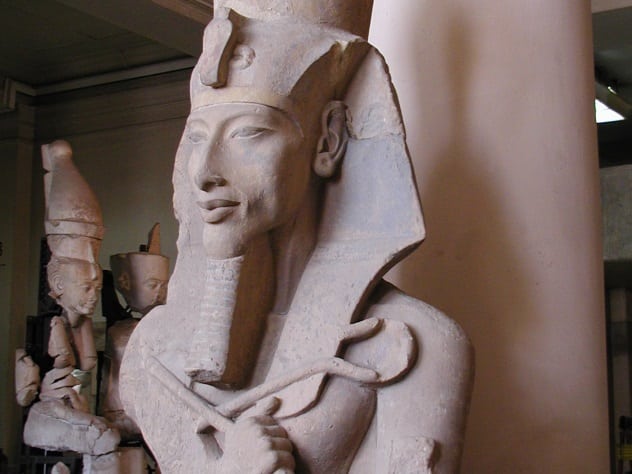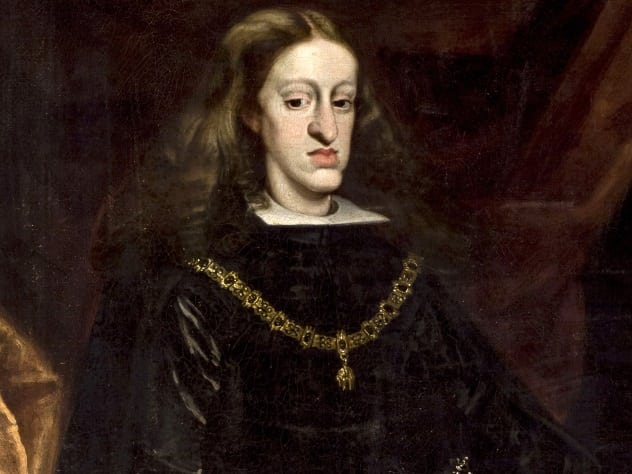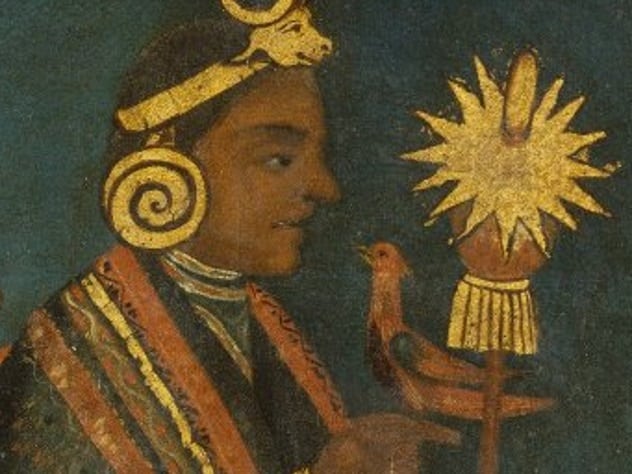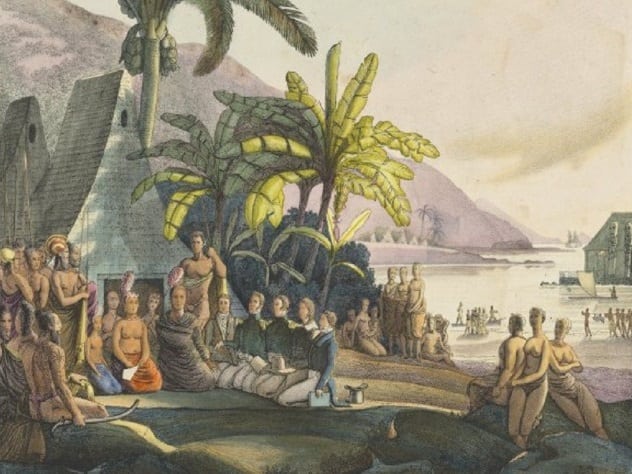Is It Incest When Animals Are Inbred?
Incest, or sexual relationships betwixt biologically close family members, is an thought that may brand your skin crawl. But information technology has oft been skilful around the globe throughout history. Royals ofttimes married close family members to keep their bloodline pure and to protect the throne politically and economically.
Cultural attitudes toward incestuous relationships vary more than 1 might imagine; while one grouping may warn of supernatural repercussions to the act, another may see spiritual virtue and deem such relationships a form of worship. The diverseness of examples from around the earth may surprise you lot.
ten Ancient Africa

In the long-gone empire of Monomotapa in Republic of zimbabwe, one rex had over 300 wives. His "principal wives" were close relatives, oft sisters or even daughters, and only their children could one day inherit the throne. These special children could only become royal heirs because of their exclusively majestic bloodline, having not been made impure by nonroyal unions. Only the rex could partake in this sectional kind of incest—nonroyal noblemen would take faced death if they tried it themselves.[i]
Royal incest likewise occurred in the Fon kingdom of Dahomey (located in nowadays-day Benin), where the king could mate with whichever woman took his fancy: single or married, foreign or native, free or slave. Fifty-fifty women from his own family were allowable, including cousins but not total sisters.
nine Ancient Arab republic of egypt

In pharaonic Egypt, it was believed that the dowry of the majestic heiress would include the throne. Non only that, but they believed that the bloodline would be strengthened past a brother-sister union. While nosotros cannot easily genetically test the offspring of these unions today, we do know that quite a few 18th-dynasty pharaohs married their sisters or half-siblings, and Ramses II in the 19th dynasty certainly did.
Akhenaten (aka Amenhotep IV) received some attention when he married his sister, Nefertiti, and it was claimed their parents were also close relatives. From his appearance in artwork from the period, experts accept speculated he may take had genetic conditions and abnormalities. This was after confirmed post-obit genomic assay on DNA samples from Tutankhamun, his son. His abnormalities may take been from mutations resulting from the commonplace marrying between brothers and sisters in the regal bloodline.[2]
eight Roman Arab republic of egypt

In Roman Egypt, those outside of the purple family were engaged in brother-sister marriages. In contrast, the Romans were confronting incestuous unions, and the marriages outlined in records were of people marrying outside the Egyptian ruling classes at the time of the Romans.
Incestuous marriages occurred beyond the economic and social divides. The virtually amazing example recorded was between twins, a spousal relationship which was said to have produced an heir. These unions, although in great number, were full-bodied in the Greek settler community, which may account for the express number of possible partners.[3]
7 Zoroastrian Iran

Zoroastrianism was the religion in Iran until the invasion of the Muslims, and the incestuous marriages of the time were tied to the religious behavior that marriage was favored by the gods, and the act was like to worship. Mother-son, brother-sis, and male parent-daughter unions were outlined in the Pahlavi texts (sixth to ninth century Advertisement) every bit having a special religious integrity.
Incestuous unions were ane of the ways Zoroastrians believed one could enter heaven as well as expunge the sins of the soul. There is fiddling to no evidence left of Zoroastrian people actually having incestuous relationships in this way, but there are enough of references to how it was seen from a religious perspective.[4]
half-dozen Europe

From the 15th to the 19th centuries, European royalty oft married between cousins. We meet this happening with the Spanish Habsburgs, the Prussian Hohenzollerns, the French Bourbons, the Russian Romanovs, and the British regal families.
Some experts believe that the turn down in families like the Spanish Habsburgs was due to inbreeding, as mental besides as physical problems began to crusade family members to deteriorate.[5]
5 Republic of madagascar

In more recent history, anthropologists take examined the Malagasy people and their relationship with incest definitions. They found the Malagasy have different views on what constitutes incest; in some pockets of Madagascar, kickoff cousins can exist man and wife, but in other regions, that is strictly taboo.
If the line is crossed into incest, either intentionally or unintentionally, they believe terrible things will happen as a result. Their crops might fail, canoes at body of water volition overturn, their children may die, women may get infertile, and nativity defects like horns or humps may follow. These consequences may happen whether the couple realize they are related or not and may not affect the husband and wife themselves but their village or community. The seriousness of the disaster befalling the customs will let them know how much atonement must be washed.[6]
4 The Incas

The Incas thought they were direct descendants of the gods. Believing their ancestors were celestial bodies, purple families mirrored the stories of the Sun, who married his sister, the Moon. When the Inca king Topa Inca Yupanqui married his sister, he was attempting to join both the father and mother's claim to the throne in the heir they would produce, and all the inheritance that would include, into i marriage.
If a purple spousal relationship was childless, the rex was and so expected to marry his second, then third sis until an heir was produced. If in that location were no sisters to choose from, he could select a first cousin to procure a reasonably pure bloodline. Royal incest ceased when the Castilian conquered the Inca people.[7]
three Polynesia

For royal brothers and sisters to produce an heir was considered to be very fortunate, and the offspring was thought to have extra mana, or power and prestige. No other claims to the throne would be considered if a strong union like this took place, and primogeniture was strictly enforced even if the firstborn was female person.
The 19th-century Hawaiian author David Malo describes the power hierarchy of Hawaiian royalty as interconnected with how related the parents of the new heir to the throne were. To go on the lineage as high-ranking equally possible, suitable partners for a principal were his own sister or (if a sister was not bachelor) a half-sister or niece. This kind of wedlock was chosen a "loop, a thing bent on itself" and was and then sacred that the offspring would be called divine. This fashion, the kid was fit to become the next chief, without competition and powerful beyond question.[eight]
2 Thailand

Thai royal men had many wives and were much more inbred than their subjects, with large harems of women from dissimilar social classes, including those of their own kin.
In 1907, the reigning rex, Paramindr Maha Chulalongkorn (aka Rama 5), had ii queens who were his half-sisters in order to procure an heir with the highest political condition possible. Incest was non expressly forbidden to those outside the royal family as it was in other cultures. Male monarch Paramindr'southward father had 84 children by 35 wives in his lifetime. Marriages were made for the royal family by "kingmakers" who were not shut relatives, and unions between uncles and nieces and between half-siblings were common in order to maximize the political royal lineage for the next generation.[9]
ane Tibet

People in Tibet exercise not discuss incest lightly, and some say it does not exist in their land at all. However, if and when information technology occurs, at that place is a special pilgrimage that may be done to purify the sins of the couple. Nal ("incest") is a word found in rituals texts and exists today with the aforementioned meaning it has for the rest of the globe.
One Tibetologist, Katia Buffetrille, recalls an business relationship from 1989 in which a couple in a Tibetan hamlet was plant to have committed incest. They were beaten by the villagers and sent to the sacred place of Chorten Nyima, a mountain on the eastern ridge in the Himalayas, adjoining Republic of india and Tibet. After they bathed in the sacred lake and spring, they obtained a sealed certificate of compliance to the ritual in the monastery and were then able to bear witness to the villagers they were now purified. Afterward, they returned to their families and previous social positions.
Incidentally, in Tibetan civilisation, had the human been of superior status, his mother would have gone to Chorten Nyima with him, and the woman would take gone with her father. One Sherpa told Buffetrille that on the journey to the sacred mount, the couple rode on a bullock accompanied by a homo on horseback simply had to walk back to the hamlet after the ritual. No stigma was fastened to the couple subsequently the sealed certificate was presented on their render.[10]
Alexa MacDermot is a psychology, sociology, and anthropology researcher living in Ireland.
Source: https://listverse.com/2018/08/07/10-fascinating-cases-of-historical-incest-from-around-the-world/
Posted by: brownefolisn.blogspot.com

0 Response to "Is It Incest When Animals Are Inbred?"
Post a Comment